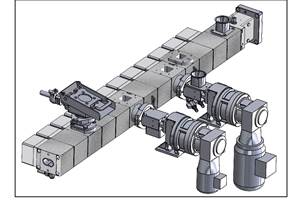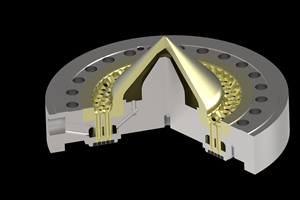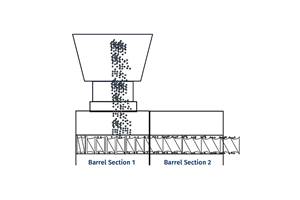More Than a Compounder: They Have the Science to Create New Custom Materials
Insight Polymers & Compounders leverages its expertise in polymer chemistry to develop next-generation materials.
A.J. Pasquale and Jeremy Lizotte go back a ways. They finished their doctoral studies in polymer chemistry from Virginia Tech in the early 2000s and followed the path laid by many 20-something graduate students before and since: They went to work for big materials companies.
Pasquale got a job at DuPont in 2002, starting in Parkersburg, W.Va., in its Teflon fluoropolymers business (which is Chemours now). Some 18 months later, he relocated to Wilmington, Del., to work in DuPont’s hydrogen fuel-cell research group. Around the same time, Lizotte finished his studies and went to work for Eastman’s polyester business in Kingsport, Tenn. In 2005, Pasquale joined Lizotte at Eastman, working in the adhesives business.
Today, the two college classmates and veterans of big polymer companies run Insight Polymers & Compounding, an up-and-coming enterprise they started in 2018 in Northeast Tennessee. Insight focuses on fully formulated systems, product-development services and proprietary masterbatches. Pasquale serves as the company’s director of operations, Lizotte as director of innovation. Together with Tony Helton, Insight’s extrusion manager, they combine nearly 100 years of polymer materials know-how, including formulated adhesives and coatings, thermoplastics, elastomers and polymer processing.
In launching Insight Polymers, the two partners saw an opportunity to meet a need for highly customized materials in a market where they felt the pace of true polymer innovation had slowed. Pasquale puts it this way. “Our experience had been with companies making polymers in big reactors. And really, the last major new polymer family to be introduced was probably polycarbonate in the 1960s. So, our thinking was that since there’s probably not going to be a whole lot of innovation with new polymer structures, there was an opportunity for a company with know-how on using additive science to add functionality to existing polymers. That’s how we see the future.”
He continues, “The impetus behind Insight Polymers goes all the way back to our graduate school days, but it really began to crystallize later in our professional careers. Working for big polymer companies was a great experience for us both. In our jobs we were regularly involved with working with smaller companies to help them innovate with our materials while helping our company commercialize new products.”
At one point in his career at Eastman, Lizotte worked in applications development, tweaking some of the polyesters the company had developed with various additives. In one case, he worked closely with a group of three entrepreneurs to develop a proprietary extrusion-coating process. “They were looking to develop a relationship with a material supplier and somebody who could develop a material specific for their application and their process. We delivered, and from those experiences I guess you can say we got bitten by the entrepreneur bug. Getting that foundational understanding of the issues with a new process and implementing a new material in a new process has been very helpful to us.”
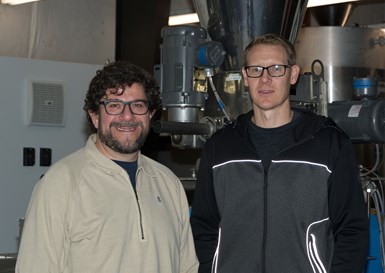
Insight Polymers & Compounding co-founders A.J. Pasquale (l.) and Jeremy Lizotte. (Photos: Insight Polymers & Compounding)
Adds Pasquale, “Both Jeremy and I have a bias for action, for creating. At bigger companies, there are a lot of people involved in decision making, and sometimes this slows things down. It was a great environment because we both had so many experts we worked with. But we had an interest in seeing whether we could take the parts of the polymer business that we really enjoyed — the innovation — to bring new advanced materials to market and do it on our own.”
States Lizotte, “Our experience has given us the opportunity to develop advanced materials without having to build a chemical plant. With a compounding operation, we were able to rent a small space, buy a couple of used extruders and get them running. Then you can do a lot of innovation by just combining materials that already exist in different new ways, adding that functionality.”
The Beginnings
At Eastman, the two had a standing lunch every week to develop a business plan, and left their positions in the spring of 2018, settling on a 6000 ft2 facility in which they continue to operate. They bought two used 16-mm (Haake) and 27-mm (Leistritz) twin-screw extruders, some previously owned auxiliary equipment, and a new chilling system. “And then we started to put together a laboratory,” Lizotte says. “We started with a differential scanning calorimeter and a rheometer. In short order we added impact testing and melt-indexing technology. Last year, we bought a small injection molding machine so that we could mold our own test samples.”
“Our experience has given us the opportunity to develop advanced materials without having to build a chemical plant.”
Within a year from launch and primarily through word of mouth, Insight Polymers attracted about 20 customers, many of which it still maintains. “It was then, and still is, a fairly diverse group,” Pasquale says. “One of our very first customers was a small injection molder that needed 5 lb of a color concentrate.” At the start, Insight Polymers also worked with a few larger compounders to take on some of the shorter runs the bigger firms might not be set up to run.
Notes Pasquale, “So, our customers have ranged from this type of small, independent, one- or two-person molding shop to large chemical companies that might have new polymers or new additives that they need tested, and they either don’t have the small-scale compounding equipment or it’s tied up with other projects.”
That first year also saw Insight do some consulting work to get the business up and running, again tapping into the co-founders’ extensive polymer science and processing expertise. “We’d have customers pay us to come to their facility,” Pasquale recalls. “They had an extruder, but they didn’t really know how to run it, and they had a project that they needed to work on. So, they paid us to come to their plant and work with their scientists for a week to make some products to test.
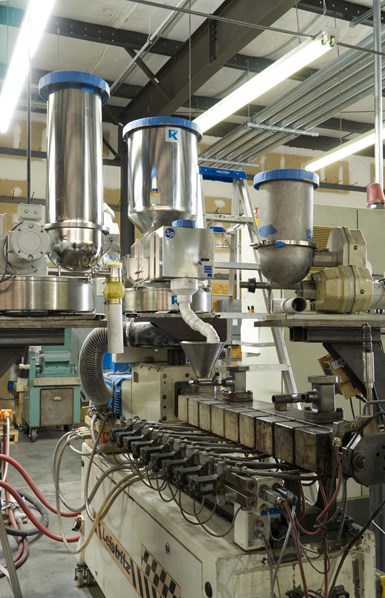
Leistritz helped Insight get this 27-mm twin-screw extruder up and running in 2018. The compounder bought it at auction, sight unseen.
“Another customer wanted to run carbon-fiber filled nylon and PETG, and we went out and determined what carbon fiber to buy and what grades of nylon or PETG they needed. Then we made them products and sent them for testing. They liked the results, and now they buy a few thousand pounds of material every few months. And we’re hoping to grow those products that we’ve been making on small scale on the larger line we just bought.”
Insight today works with a wide range of materials: engineering resins such as nylon, PEEK, PPS, and PETG, as well as TPEs and functional olefins and exotic fillers. It considers its expertise falling in these four buckets:
- Product Development: Implementing novel development process design and product formulation with Insight’s twin-screw extrusion pilot lines. Insight can carry out small development batch trials and quickly screen product and processing parameters for proof-of-concept demonstration and small-scale manufacturing.
- Specialty Compounding: Creating and/or adding functionality such as conductivity, aesthetics, flame retardance, toughness, strength, thermal stability, and surface properties to base resins via incorporation of a wide range of additives.
- Masterbatch Concentrates: Colors and/or performance additives that allow processors to economically add functionality during processing. Insight’s expertise includes a wide range of polymer resins and blends, additives, modifiers, fillers and nanocomposites.
- Fully Formulated Compounds: Ready-to-use compounds for downstream processing to produce injection molded parts, fibers, films or FDM filament for additive manufacturing. Can be as simple as a base resin and an additive (such as nylon with a reinforcing fiber) to a compound with several resins and additives (e.g., an automotive interior TPO formulation).
Of course, starting a new business from scratch did not come without a learning curve. Says Pasquale, “We started Insight Polymers with a lot of experience in polymer chemistry, but we also had history working with salespeople and customers; we both had had a lot of customer interaction. Some of the other matters involved in running a business we’ve learned on the fly. We never had to worry about price negotiations and following up on getting paid. All of the transactional aspects of running a business were new, but Jeremy and I work well together and divided some of those responsibilities.
Adds Lizotte, “We both had done R&D on lab and pilot-scale equipment, but we never had to fix it when it broke down. We were used to having a maintenance department when something failed, but over time we have been able to pick up the necessary skills.”
Recent Developments
The two also give kudos to Leistritz for helping it get their business off and running. The used 27-mm twin-screw they bought in 2018 — sight unseen at an auction — came with a manual, which unfortunately for them was written in German. (Leistritz’s U.S. operation is in Somerville, N.J., but its global headquarters is in Nuremberg, Germany.) They used Google Translate to help with that problem, but Leistritz in New Jersey assisted the new company with repairs and spare parts, some of which were hard to come by.
Late last year, Insight Polymers added a Leistritz ZSE 40-MAXX twin-screw to support what Pasquale calls “specialized services that keep pace with our customers’ needs in the advanced polymer compounding areas — in particular for additive manufacturing and conductive polymer applications.” Adds Lizotte, “This new capability supports our ability not only to extend the range of composite materials with higher concentrations and better dispersion of reinforcements and functional additives, but it also extends our ability to do reactive processing and mechanochemistry, which we see as essential to meet new performance criteria.”
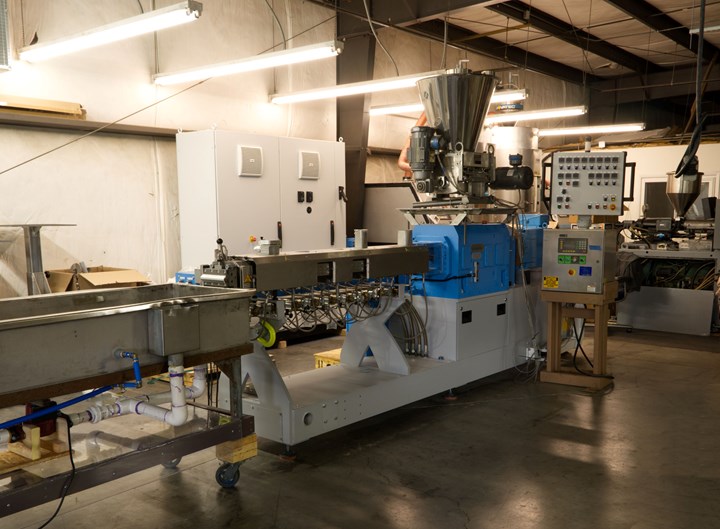
Recently installed 40-mm twin-screw will allow Insight to support customers who have ramped up their demand for customized compounds.
The need for a new 40-mm twin came about in part because of Insight’s initial successes in developing new formulations for customers that now need bigger orders. Explains Pasquale, “We’ve got a few customers ordering only 500 to 2000 lb, maybe once a quarter or twice a year. But other customers we’ve been working with are now getting to the point where they might scale up to 10,000 or 20,000 lb orders. The new line will allow us to bridge into ‘medium-scale’ production. Now, if these customers get up to the point where they’re needing millions of pounds a year, then we would still probably work with a partner, and we’ve got actually one.”
Insight engineered a conveying system to complement the new line. “With the smaller extruders we’ve had a very manual process,” Lizotte says. “But with the new line we’re trying to automate it more, which makes sense if you’re running several hundred pounds an hour.”
What’s Next?
Both Pasquale and Lizotte believe their backgrounds in polymer chemistry position them to help grow the business and help their customers develop new material solutions. “I don’t think I’d characterize a lot of the companies we helped as being materials-development companies themselves,” Pasquale explains. “Sometimes they have a new additive that they’re looking to understand. Or maybe they have a formulation concept, and idea of what they want the product to do from the standpoint of properties. We’ve consulted with customers that were focused on properties, but did not fully appreciate structural property chemistry, chemical interactions. We can bring that aspect too, that deep knowledge of chemistry.”
Lizotte continues, “Most of the people in this industry are engineers. We bring a different perspective with our experience in polymer chemistry. We can help them refine their ideas and create solutions. And I think when we start talking about developing new materials, either the attachment of molecules to polymer backbones or the building up of unique polymers using the extruder as the reactor, those are ways to develop new materials in the future that maybe we haven't looked at through compounding.”
Related Content
Strategically Manage Pressure to Help Ensure Quality in Co-Rotating Twin-Screw Extrusion
Pressure measurement provides an invaluable window into any extrusion process, but it must also be strategically managed at every stage of the process to ensure a quality part is being extruded.
Read MoreHow to Maintain Pelletizing Quality When Acid Attacks
Developments in the chemistry of polymers and additives have made corrosion a real problem in pelletizers. Here’s how to ward it off.
Read MoreHow to Configure Your Twin-Screw Extruder -- Part 2
Follow these tips to configure your twin-screw elements to promote feeding and solids conveying.
Read MoreProcessing Megatrends Drive New Product Developments at NPE2024
It’s all about sustainability and the circular economy, and it will be on display in Orlando across all the major processes. But there will be plenty to see in automation, AI and machine learning as well.
Read MoreRead Next
Beyond Prototypes: 8 Ways the Plastics Industry Is Using 3D Printing
Plastics processors are finding applications for 3D printing around the plant and across the supply chain. Here are 8 examples to look for at NPE2024.
Read MoreFor PLASTICS' CEO Seaholm, NPE to Shine Light on Sustainability Successes
With advocacy, communication and sustainability as three main pillars, Seaholm leads a trade association to NPE that ‘is more active today than we have ever been.’
Read MoreMaking the Circular Economy a Reality
Driven by brand owner demands and new worldwide legislation, the entire supply chain is working toward the shift to circularity, with some evidence the circular economy has already begun.
Read More








